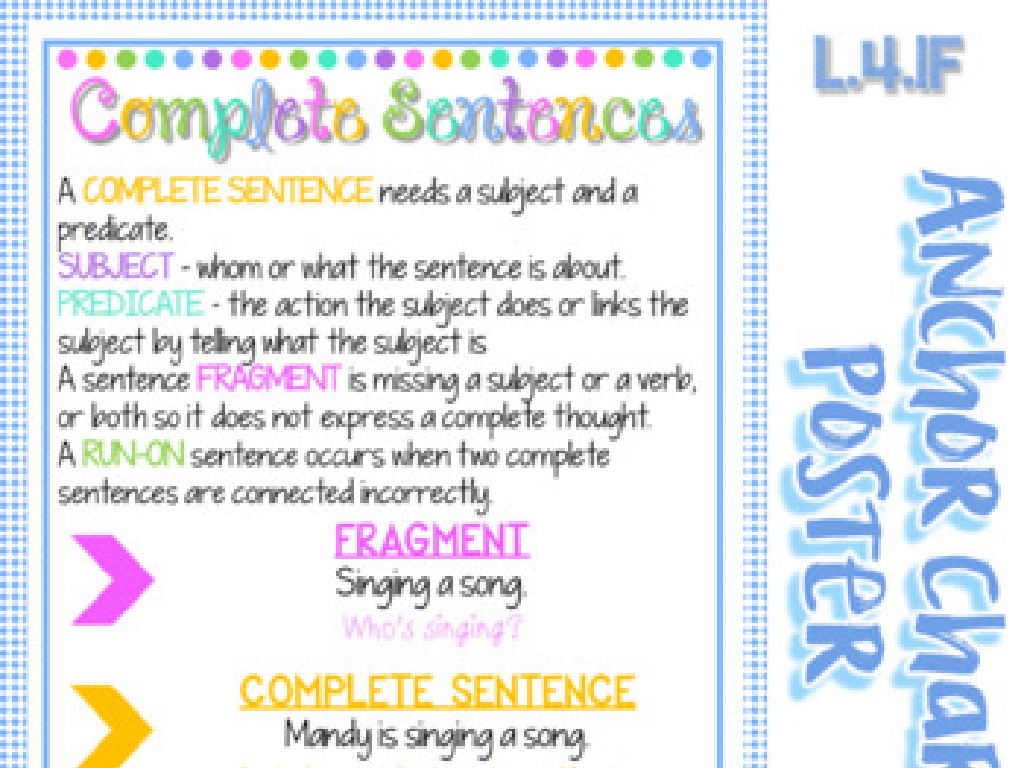Replace The Noun With A Personal Pronoun
Subject: Language arts
Grade: Fifth grade
Topic: Pronouns
Please LOG IN to download the presentation. Access is available to registered users only.
View More Content
Today’s Adventure: Replacing Nouns with Personal Pronouns
– Pronouns take the place of nouns
– Instead of ‘Sarah likes Sarah’s car’, use ‘She likes her car’
– They prevent repetition
– ‘The dog chased the dog’s tail’ becomes ‘The dog chased its tail’
– Pronouns suit different sentence roles
– ‘I, you, he, she, it, we, they’ fit as subjects or objects
– Pronouns make sentences smoother
– ‘Give the book to John or give it to him?’ Which sounds better?
|
This slide introduces the concept of personal pronouns and their function in sentences. Pronouns are used to replace nouns to avoid repetition and make sentences flow better. They can act as subjects or objects within a sentence. It’s important to teach students how to identify the noun that the pronoun is replacing to ensure clarity in their writing. Use examples to show how replacing nouns with pronouns can simplify sentences and make them less cumbersome. Encourage students to practice by rewriting sentences from their favorite books, replacing nouns with appropriate pronouns.
Understanding Pronouns
– What is a pronoun?
– A word that takes the place of a noun
– Different types of pronouns
– Focus on personal pronouns
– Personal pronouns represent specific people or things
– Examples: he, she, it, they
– ‘He’ for boys, ‘she’ for girls, ‘it’ for objects, ‘they’ for groups
|
This slide introduces the concept of pronouns, which are words used in place of nouns to avoid repetition and simplify sentences. Emphasize the role of personal pronouns, which refer to specific people or things. Provide clear examples for each personal pronoun, such as ‘he’ for a boy named John, ‘she’ for a girl named Mary, ‘it’ for a cat, ‘they’ for a group of friends, ‘you’ when speaking to someone directly, and ‘we’ when including yourself in a group. Encourage students to practice by replacing nouns in sentences with appropriate personal pronouns. This will help them understand how pronouns function in everyday language.
The Power of Pronouns: Why Use Them?
– Pronouns prevent repetition
– Instead of ‘Sarah said Sarah lost Sarah s pen’, use ‘she’ and ‘her’
– They simplify sentences
– ‘The dog played and the dog barked’ becomes ‘It played and barked’
– Pronouns clarify our message
– Clear communication is key in both speech and writing
– Exercise: Spot repetitive nouns
|
This slide introduces the concept of pronouns and their importance in language. Pronouns help us avoid unnecessary repetition, making our speech and writing more fluid and easier to understand. They also contribute to sentence clarity by eliminating the overuse of nouns. The exercise included will help students identify and replace repetitive nouns with appropriate pronouns, reinforcing the concept. Encourage students to think about how pronouns function in sentences they hear every day and to be prepared to discuss examples from the exercise in the next class.
Replacing Nouns with Personal Pronouns
– Identify nouns in sentences
– Find the person, place, thing, or idea
– Choose correct personal pronouns
– Match the pronoun to the noun’s number and gender
– Practice with examples
– ‘Sarah loves her cat’ becomes ‘She loves it’
– Guided assistance for clarity
– Step-by-step walkthrough of each example
|
This slide is aimed at teaching students how to replace nouns with appropriate personal pronouns to avoid repetition and improve sentence flow. Start by explaining what a noun is and how to spot it in a sentence. Then, discuss personal pronouns and how they must agree with the nouns they replace in number (singular or plural) and gender (male, female, or neutral). Use practice examples to illustrate the concept, such as replacing names with ‘he’, ‘she’, or ‘they’ and objects with ‘it’, ‘them’, etc. Provide guided assistance by breaking down sentences and analyzing them together. Encourage students to ask questions and provide additional examples if needed.
Let’s Practice Pronouns Together!
– Activity: Fill in the blanks with pronouns
– Group Work: Rewrite sentences using pronouns
– Work together to replace nouns with ‘he’, ‘she’, ‘it’, ‘they’, etc.
– Share your new sentences
– Each group will read their sentences aloud
– Understand pronoun usage
– Learn how pronouns can take the place of nouns
|
This slide introduces a class activity focused on the practical application of pronouns. Begin with an individual activity where students fill in the blanks in sentences with appropriate pronouns. Then, move on to group work, where students collaborate to rewrite sentences from a paragraph, replacing nouns with pronouns. This will help them understand how pronouns function in different contexts. After the group work, have each group share their rewritten sentences with the class to foster a collaborative learning environment. The teacher should prepare a worksheet with sentences and a short paragraph for the activities and be ready to assist groups as needed. Possible variations of the activity could include focusing on possessive pronouns, reflexive pronouns, or indefinite pronouns to cater to different learning levels.
Pronoun Agreement
– Pronouns match antecedents
– A pronoun must agree with the noun it replaces in both number (singular/plural) and gender.
– Examples: right and wrong
– ‘Alex rode his bike’ is correct. ‘Alex rode their bike’ is incorrect if we know Alex identifies as he.
– Activity: Fix the errors
– Find and correct pronoun agreement mistakes in given sentences.
– Understand agreement rules
|
This slide introduces the concept of pronoun agreement, emphasizing the importance of matching pronouns with their antecedents in both number and gender. Provide clear examples of correct and incorrect usage to illustrate the concept. The individual activity is designed to reinforce learning by having students identify and correct pronoun agreement errors in a series of sentences. This will help them apply the rules of pronoun agreement in practical situations. As a teacher, be prepared to explain common errors and guide students through the correction process. Offer additional examples if needed and encourage students to explain their reasoning for choosing specific pronouns.
Game Time: Pronoun Hunt!
– Interactive pronoun replacement game
– Find nouns in a story and switch them with pronouns
– Pair up and play the game
– Work together with a classmate to complete the challenge
– Discuss reading ease post-game
– Was the story simpler or more complex with pronouns? Why?
– Reflect on pronoun usage
– Think about how pronouns affect our reading and understanding
|
This slide introduces an interactive classroom activity designed to reinforce the concept of pronouns. Students will work in pairs to identify nouns within a provided story and replace them with appropriate personal pronouns. After completing the activity, they will discuss as a class how the use of pronouns changed the readability of the story. This exercise aims to enhance their understanding of pronouns and their function in sentences. It also encourages critical thinking about language structure and comprehension. Teachers should prepare a story with a mix of easily identifiable nouns and some that are more challenging to replace, to cater to different skill levels within the class.
Wrapping Up: Personal Pronouns & Homework
– Recap on personal pronouns
– We learned how to replace nouns with he, she, it, they, etc.
– Why pronouns matter
– Pronouns help us avoid repetition and make sentences smoother
– Homework: A pronoun story
– Write a story using ‘I’, ‘you’, ‘he’, ‘she’, ‘it’, ‘we’, ‘they’
– Practice makes perfect
|
As we conclude today’s lesson, remind students of the key points about personal pronouns. Emphasize the importance of using pronouns to make our writing clearer and less repetitive. For homework, students should write a short story where they focus on replacing nouns with the correct personal pronouns. This will help them practice what they’ve learned. Encourage creativity in their stories, and remind them to proofread to ensure they’ve used pronouns correctly. In the next class, we can have a few students share their stories to reinforce learning and celebrate their efforts.






